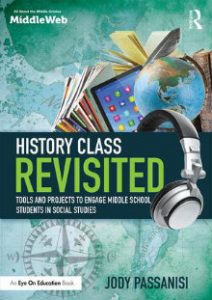Warm Ways to Deepen Historical Thinking
History Class Revisited: Tools and Projects to Engage Middle School Students in Social Studies
By Jody Passanisi
(Routledge/MiddleWeb, 2016 – Learn more)

Reading History Class Revisited in the summer made me really miss the middle schoolers who fill my classroom each fall. On each page, Jody Passanisi shows a deep knowledge and affection for these students’ minds and hearts. Along the way she offers a multitude of concrete and implementable strategies to help these young adolescents on the way from literal to metaphorical thinking.

The first two chapters, about middle school students in general and the routines they crave, would be useful reading for any teacher new to these grade levels. A simple and effective note-taking structure with evidence in one column, conclusions in another and a summary at the bottom makes for an excellent graphic organizer. Passanisi also emphasizes reflection and metacognition as key to any set of classroom routines.
The next three chapters go deep into engaging with language: reading and analyzing expository texts, evaluating perspective, and writing to make an argument.
Middle schoolers can think critically with our support
Passanisi’s bedrock assumption is that middle schoolers can think critically if we give them the tools and time to do so – and that historiography, along with other sophisticated concepts, “activates the part of the middle schooler that is genuinely interested” (49).
She asserts that students need to “do something with what they read” rather than “sleepwalk-read” (33-4) and provides many strategies to encourage active engagement with texts. A chapter on historiography pulls together exciting models teachers can use to spark student interest, including Tupac’s “Changes” and the Charlie Daniels Band’s “In America.”
I enjoyed hearing about Passanisi’s evolution as a teacher of writing. She is honest about what has worked well and what she has needed to revise. Her approach to citations is also age appropriate and gives a foundation for more nuanced work in high school and beyond.
Relevance, engagement, inquiry, and assessment
Chapters Six through Nine on relevance, engagement, inquiry, and assessment feel rich and full, a natural culmination of the skills-based chapters preceding them. Taken as a whole, they give middle school students “a real and deep reason to care” (67). Passanisi offers too many activities to list all of them here, including writing parodies, brainstorming on her classroom’s IdeaPaint Wall, analyzing the ways in which current events are not only written but reported, and engaging in a Revolutionary War simulation that included wadded-paper guerrilla warfare.
All of her activities, especially the long-term projects, show a firm belief in student ownership and creativity – in giving students the time and agency to figure things out. An assignment on Civil War technology from the end of the year shows a nice blend of skills and open-endedness.
The prompt reads: “In teams, create a project that examines an answer(s) to this question: How did your technology change the Civil War?” Following is a stipulation that “Your project must fully answer the question and be beautiful, meaningful, sophisticated, and enduring (adapted from [progressive educator] Gary Stager)” (106).
If I had one unfulfilled wish for this book, it was that I wanted to see student samples. Many of the projects and activities Passanisi describes sound like so much fun that student work would inspire me still further.
An accessible book with sticky ideas
From start to finish, History Class Revisited seems like chatting with a seasoned mentor. From the book’s easy tone, I imagine that Passanisi approaches her classroom with the relaxed humor that comes from living with middle schoolers, day in and day out, for years on end.
Her ideas stick – in fact, I found myself returning to her chapter on reading expository texts before introducing the first primary document and secondary analysis to my students this year. And I know her open-minded, student-centered approach will stay in my mind in the months to come.
As Passanisi notes, at times veteran teachers “feel like you wouldn’t want to be anywhere else than with these wild and crazy middle school kids” (5). Her book reminded me of the bouncy pleasures of a classroom filled with young adolescents, ready to learn.
Sarah Cooper teaches eighth-grade U.S. history and is dean of studies at Flintridge Preparatory School in La Canada, California. She lives just outside Los Angeles with her husband and two sons. Sarah is the author of Making History Mine (Stenhouse, 2009). She writes articles and reviews books for MiddleWeb. She is also a contributor, as is Jody Passanissi, to the MiddleWeb blog Future of History. The two have never met.




































Sounds like the way history should be taught. Thanks for a great review!
Receive a 20% discount on History Class Revisited at the publisher’s website, with the code MWEB1.